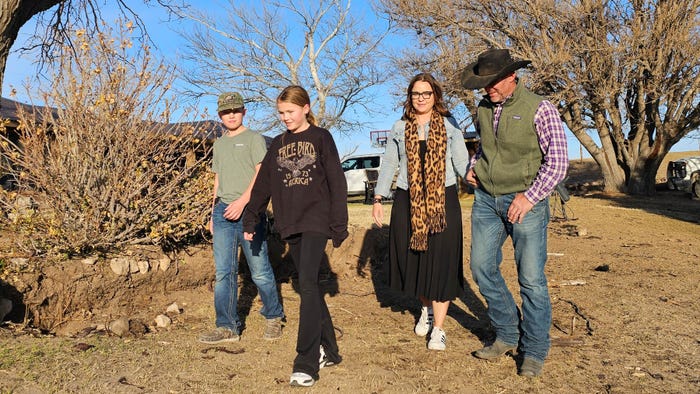
In this 3-part series, two Texas Panhandle families, who happen to be related but live in different communities, share their accounts of outrunning and surviving the Smokehouse Creek fire.
Prior to the state’s largest wildfire, calving had begun on the Fields Mahler Simmental Ranch near Canadian, Texas. Hundreds of bluestem round bales were on hand, and spring was in the air.
Then Monday evening, Feb. 26, a bad feeling came over ranch manager Shane Pennington and his wife, Tatum. The winds escalated. Smoke could be seen in the distant canyon. The weathermen were warning of extreme fire danger due to gusting winds.

Shane Pennington visits will fellow rancher and volunteer Travis Francis. (Photo by Shelley E. Huguley)
As the Pennington’s lay in bed, they prayed, “God, just don’t let the winds blow tomorrow, please.”
They woke to smolder. Shane moved cattle out of the west pasture down into a meadow. “Smoke was coming from my neighbor’s headquarters. We’re not going to be OK today,” he thought.
Tatum called work and stayed behind in case they needed to load up and evacuate. “You might wait a second,” Shane told her.
Thirty minutes later, a massive wildfire, was moving rapidly.
“The fire kept pushing this way and pushing us back to Canadian,” Shane said.
“Whenever we’ve had other close calls, we’ve always said if the fire ever gets in the river bottom, you’re going to be in trouble because the grass is so tall, and it’ll move so fast it will go straight to town. And that’s exactly what it did,” Tatum said.
This fire and others grew into what is now known as the Smokehouse Creek fire – the largest in Texas history, consuming over one million acres.
It raged throughout Tuesday, driving the Penningtons and so many others from their ranches and homes, as an evacuation order was issued, and the highways were eventually closed. Flames surrounded the city and burned for more than 20 hours.
The fire eventually settled enough for Shane and Tatum to return to their ranch the next morning. The search began for live cattle across thousands of acres of blackened rangeland.
“The first day, we found more dead than alive… ones that had to be shot,” Tatum recalls. “And then it was like, where do we put the ones that are okay. What about the pairs? Are there any that are still with their moms?
“They all got mixed up. We’re still waiting for them to pair up and see which ones don’t have a mom.”
Shane found two calves that survived on the other side of the river, “which is pretty remarkable,” Tatum adds. “I don’t know how they’re alive.”

Cattle found alive following the wildfire. (Photo by Shelley E. Huguley)
Only one set of pens remains, which is where they’re gathering the live cattle. “None of them want to move. They’re like, ‘No way am I going back over there,’” Tatum said. The couple guesses the cattle found refuge in the river bottom.
Each passing day
Shane has located most of the remaining cattle. Some of the surviving calves seem to be worsening daily, showing signs of respiratory issues.
He’s worried about the long-term impact of smoke damage to their lungs. “As they grow and their body gets bigger, that lung capacity won't be there, so they won’t be able to support a bigger body, a bigger frame down the road.
“It’s just devasting. Where do you start and stop putting them down?”
The Pennington’s have buried at least 60 so far.
Live cattle are still being found. “Everyone says they’ll group up a bunch, and then they’ll look behind the truck and here comes a straggler. They’re coming in from everywhere,” Tatum said.
Hemphill County has received over 700 loads of hay. Donated hay has kept the cattle from wondering. “They kept getting out because we didn’t have any hay. It all burned up,” Shane said. The fire consumed the 800 to 900 bales that they baled on the ranch last summer. “We were sitting pretty good.”

Pennington family is thankful for ranch and their way of life. (Photo by Shelley E. Huguley)
While he’s grateful, Shane’s not sure how much hay to accept. As cattle continue to perish, he’s unsure how much hay he’ll need or how soon he’ll have more cattle to feed. “You hate for that hay to sit there and rot or lay out in the weather because it won’t be as good in two years.”
Starting over
The Penningtons, like so many other Panhandle families, are “essentially starting from square one,” as Tatum put it. So much remains uncertain, and the road ahead is long. They’re thankful for the ranch, its owner, Jack Fields, and the way of life it has provided.
“It’s hard to see this place we’ve been on for so long just destroyed in such a way,” Shane said. “It’s meant so much to us, and Jack means the world to us. I’ve never worked for somebody that treats my wife and my kids the way he treats them… He’s not all business when he shows up and that means a lot.
“He and his dad care a lot about these cattle and now I do, too. It’s just hard to see them destroyed when I’ve spent every day trying to take care of them and keep them alive.”
But he’s hopeful for a future when the Fields Mahler Simmental Ranch is once again covered in cattle.
For more information about how or where to give to help families in the Panhandle rebuild, visit Texas A&M AgriLife's 2024 Texas Panhandle Wildfire Relief Resources.
About the Author(s)
You May Also Like






